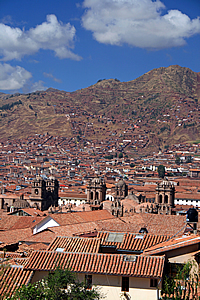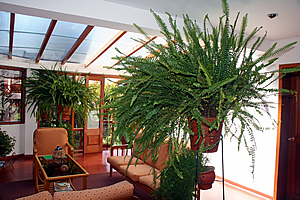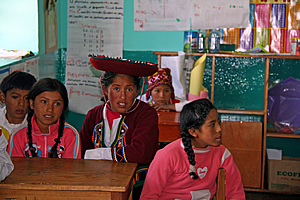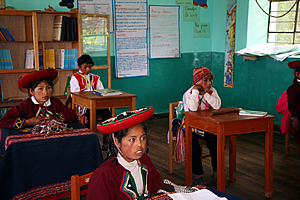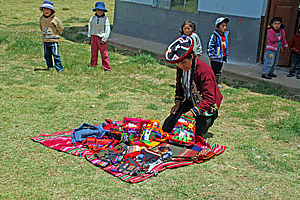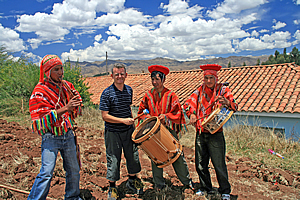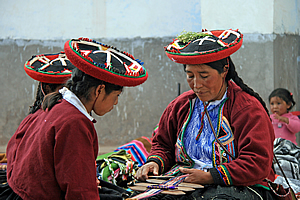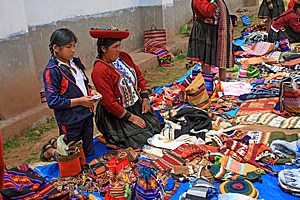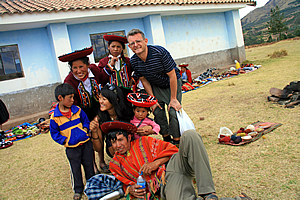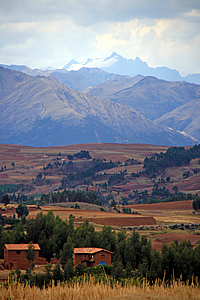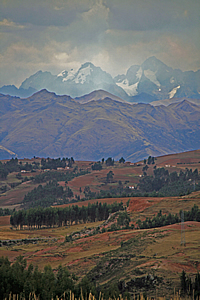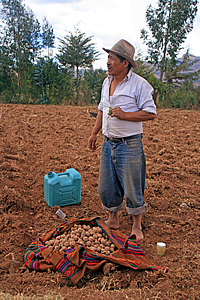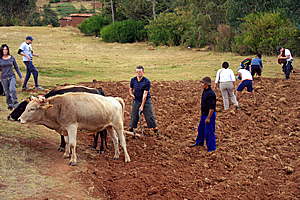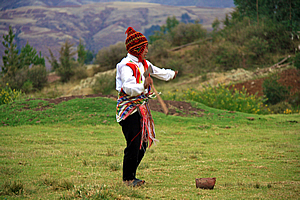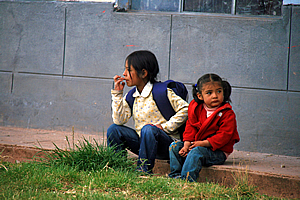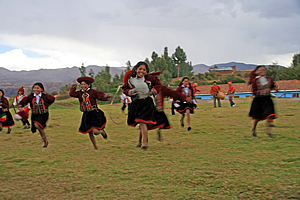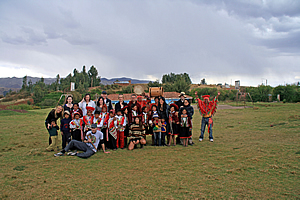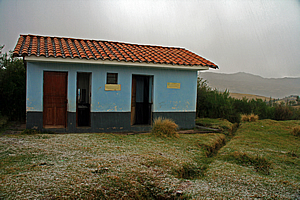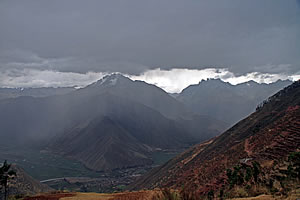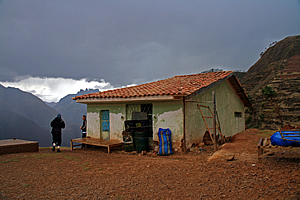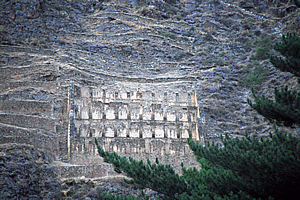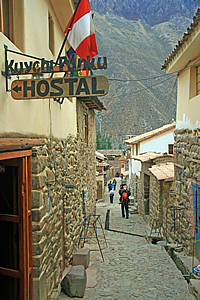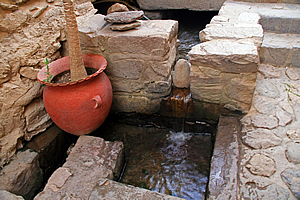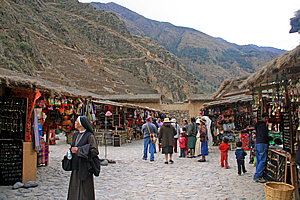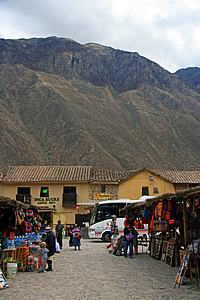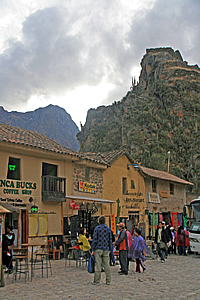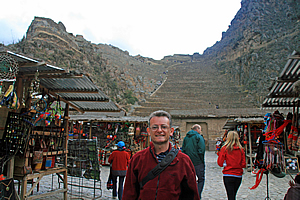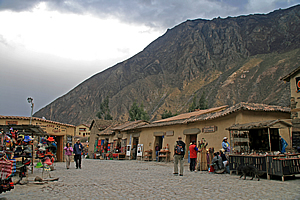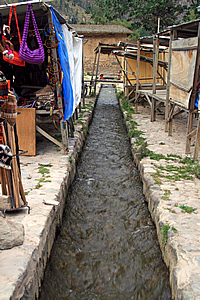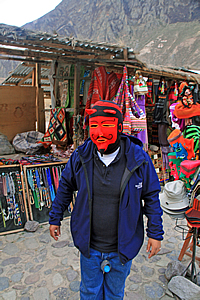|
||||||||||||||||||||||||||||||||||||||||||||||||||||||||||||||||
|
||||||||||||||||||||||||||||||||||||||||||||||||||||||||||||||||
Home > Treks > Outside Australasia > Inca Trail > 2 |
||||||||||||||||||||||||||||||||||||||||||||||||||||||||||||||||
|
||||||||||||||||||||||||||||||||||||||||||||||||||||||||||||||||
Introduction to today's journeyAs we used to say in the mountains, 'Breathe. Breathe again. With every breath, you are alive.' After all these years, this still the best advice I can give you: Savour your existence. Live every moment. Do not waste a breath. - Nando Parrado. Today's journey takes us out of Cusco heading towards the Sacred Valley. We stop at a farming village to experience modern Quechuan culture before descending into the valley to the village of Ollantaytambo where we do our final preparations to begin the trek tomorrow. Today's JourneyDistance trekked today: 2 kilometres. Total distance trekked to date: 5 kilometres. WE LEFT Cusco early the next morning following breakfast. It was a clear day as it had always been every morning so far here in South America, having rewarded us with a fantastic view outside the dining hall across the array of terracotta roofs over the city as we ate breakfast. As usual we had only been given. To our horror we had discovered last night exploring the city that most jam in this country was branded under the name “Fanny”. I now found that most disconcerting seeing a jar of red viscous fluid on the breakfast table that I now knew was branded “Fanny”. Clearly that was a very unfortunate thing lost in translation. The fanny jam on the table really put me off breakfast. Thankfully we had more than made up for it with the bright view.
As I was trying to contemplate breakfast, Ryan and Kristen from my group arrived and joined me in the tiny dining room. They were from the Gold Coast less than a hundred kilometres from where I live. They had just married and were on their honeymoon. We hadn’t heard anything yet as to how Michael was going with his recovery from the stomach bug he had caught in the Amazon. We will be starting to walk the trail tomorrow, so we were hoping he will be well enough to do it with us. Once breakfast was finished, we had packed up and assembled outside the reception area with our array of luggage. Our tour leader Luis arrived announcing all thirty three of the Chilean miners who had been trapped for a month deep underground had been successfully rescued using an ingenious rescue capsule. The rescue had taken all day and all thirty three had been extracted seven hundred metres to the surface one by one without incident. We were all very happy they had been rescued.
Fortunately Michael was feeling quite a bit better this morning, having been prescribed some medication yesterday. It was obviously working. The van took quite a while to arrive, but once it was parked outside in the turning bay, we left the hotel and walked along the narrow lane and piled in. The van ambled its way precariously down the very narrow streets which were hardly wider than the van itself, into the city. We passed through the middle of the city before heading uphill to follow the highway out of the city heading south. The highway followed the route of the Inca Trail, which when built five hundred years ago started in Cusco and ended at Machu Picchu. The highway climbed to the highest suburbs around the bowl valley giving us a great view across the city. The road followed next to a surprisingly steep graded railway line, probably one of the highest in the world. Finally we crossed over a small saddle at around three thousand six hundred and fifty metres above sea level still following the railway line and still in the outer suburbs of Cusco which spread out in the gully beyond. We followed the road downhill along the bottom of a valley for a short distance before turning off to the right off the main road. From here we could see snow for the first time in some distant mountains directly ahead of us. We will be walking amongst those mountains over the next few days. The main road we had turned off continued working its way downhill until eventually reaching Lima some nine hundred kilometres away over about thirteen hours’ drive away. By now we were out in the countryside in amongst farmland. The side road off the main highway we took was well sealed. It was a very well-travelled road, being the main tourist route between Cusco and Machu Picchu. Almost immediately the road started going gradually uphill again, winding through fertile farmland with brown grass and fields of potatoes. We eventually reached a turnoff in the Chinchero area about half an hour after leaving Cusco. At the turn-off a couple of children excitedly greeted us. They were dressed in brimmed dark red hats, and matching jackets very elaborately decorated. We picked them up and headed towards their village by following a gravel road climbing steeply uphill along a valley with a cascading stream just below us. Then the road turned on a hairpin bend to head up the hill until eventually reaching a ridge. Then the road doubled back and followed the ridge moderately uphill for about a kilometre or two before reaching a village. We were above 3700 metres above sea level here, almost level with the height of Mount Cook, New Zealand’s highest mountain. I had been at this altitude once before earlier this year whilst climbing Mount Kinabalu. By this altitude though, we had been far above any signs of civilisation. Here in Peru living at this altitude seemed as normal as living at sea level in Australia. Ahead lay the small village of the Incan descendant farmers. The driver parked the minibus by the side of the gravel road and walked into a school yard. One of the teachers came to meet us, and took us into her classroom. There were ten children in the classroom some dressed in the same traditional Peruvian clothing the children we had picked up were wearing. They were of different ages, but all had the deeply tanned skin and rosy cheeks expected of people living at such high altitudes. The cheeks on their triangular faces were bright red from having lived at this high altitude all their lives. The walls were painted a pastel greenish blue colour. There were numerous posters hanging around, many in Spanish, and some in the indigenous Quechuan language of the Inca. Quechua is one of the most difficult languages to learn, but it is still taught in the schools here as a means of keeping the ancient Inca culture alive despite having been overthrown by the Spaniards some five hundred years ago.
A nearby poster read (I’ll do the characters as close as possible to what was actually written): d Llaqtay riqsitya munankitchu? Umamarca sutiyuqmi llaqtayqo. Urqukanapa chawpinpi tarikun chakra patakunapiqa hatun sash’akuna, hatun mallkikuna winan. Sispanpi huk ch’uya mayu kan. Challwa mayu sutiyuq. Chaypim sapa p’unchaw mayllakuyku, t’aqsakuyku ima. Umamarkaqo winachkanna; Kunanqa achka wasikunayuq, musuq nanniyoq; musuq yachay wasiwuq ima.
Chaypi tiyaqkunapus allin runa kaniku. Kaqtaqmi mayninpiqa sinchi machaq runakunapas. !Sumaqllatanam llaqtayqa winachkan! Chaymi anchata munakuni. The children stood up and introduced themselves in their native language and performed a couple of songs for us. This would have really been something for them as we were the first tour group to visit this particular village. I wondered if they had any idea on the scale of the enormous distances we had travelled around the world to come and visit them.
Once finished in the classroom, we returned outside in the bright sunshine. Led by three musicians carrying and playing their instruments, we walked around the classroom to a short trail to a large potato paddock. One of the musicians was playing a small drum, another playing a recorder-like flute, and the other was playing a large drum. On our way up we saw an old lady kneeling on a bright blue and red tartan picnic rug with numerous wares she had made for sale. We passed a small blue tap with water constantly dribbling out into a tray below. This was where the locals collected their drinking and washing water. We climbed a short steep embankment to a large potato field with raised mounds of unbroken clods running along the top.
Here we built an oven out of clods of soil. It was essentially an igloo shape with an opening in the front where we filled it with wood, gum leaves and spuds. I had noticed a lot of Australian gum trees growing around there. They were obviously an exotic species, but they were very useful here, probably growing faster than the native species and burning better as firewood. Once the dirt oven was loaded with wood, dried leaves and spuds, we lit a rather smoky fire. The three musicians continued playing their traditional Peruvian music as the smoke billowed out of the gaps in the oven. I had a go on the large drum.
Once the fire in the oven was well established with a good bed of embers, we returned to the green of the school yard. The children were now on a field and in front of the classroom were numerous plastic chairs laid out for us to sit on. The musicians started playing their traditional instruments again and the children began to perform a dance. We watched them for about five minutes before one by one they came to the audience and pulled one of us out to join them. Soon we were all dancing with them – well as best as we could.
Once the dance was over, the children walked us hand in hand back to the gravel road where we continued to follow it for another half a kilometre up the ridge. We passed several mud brick houses under construction to a grassy park where several short and squat women of the village had large blankets laid out with numerous things they have made to sell to us. They demonstrated the spinning and weaving of the fine alpaca wool, stretching it out to a small stake about two metres away, and pulling it into wool. The ladies were all wearing the traditional red costume and hats, and the similarly dressed girls surrounded them eager to learn their craft. They showed us the natural dyes they create from native plants soils. No doubt these colours have been used here for many hundreds of years.
We looked at all the products. I bought a new leather wallet (my old one was starting to fall apart) and a woven table runner. The wallet was intricately carved leather with Incan symbols all over it. A few of the others bought clothes and souvenirs. Then we all posed with the children and musicians for several photos. I got a good shot of one of the young girls using Amy’s camera. The girl used mine as well to get some pictures. Looking at the pictures afterwards she obviously wasn’t very experienced at all. Hopefully after a few more tour groups come through she will be a fantastic photographer.
|
||||||||||||||||||||||||||||||||||||||||||||||||||||||||||||||||
The Inca Trail is on the other side of these mountains |
By now the sky was getting overcast with some ominous clouds forming over the mountains. I realised the weather could change very suddenly with us being at such a high altitude in amongst substantial mountains towering to over six kilometres above sea level. The musicians led us walking hand in hand with the children a bit further up the road until we reached a potato farm. There were two oxen yoked together to a small plough. Several women with large woollen bags slung over their shoulders full of seed potatoes were planting them in the furrows the oxen were digging.
Potato farmer |
The farmer gave us a demonstration on planting potatoes. He seemed very Mexican in appearance wearing a wide brimmed hat and no shoes. He told us how the potato is planted. Then he showed us some home brewed corn beer to try. It was disgusting – nothing more than rotten corn juice.
Even Luis screwed up his face when he tried it. The farmer poured some of the corn beer out of a jerry can and sprinkled it over the seed potatoes in some form of blessing ritual. We had the opportunity to help the labourers with planting potatoes.
I was fortunate in having a go at ploughing a couple of furrows with a plough drawn by two cows. I had to push the plough hard into the ground to make it penetrate properly, but it worked well once the cows were moving.
I attempt to plough the field |
Luis quickly became the camera stand. We had all given him our cameras to take photos of us. He was loaded with them. Fortunately I had my little camera with me, and I managed to get a good picture of him loaded up with all the cameras. That was an idea I had in the Amazon where I had seen him loaded up with our cameras and thought that would be such a wonderful shot. Unfortunately at the time I didn’t have my credit card camera. I made sure I had it with me today.
Once the ploughing was finished, we walked back to the school for lunch. The sky was dark and clouds were starting to envelope the mountaintops. We passed the field where we had set up the potato oven. Some women were now dismantling it, on the assumption the spuds were properly cooked by now.
Upon returning to the school, we were entertained by another dance by the children of the village. They were all wearing their dark red, black and white traditional costumes It was hard to understand what was going on as they were dancing in circles – usually the boys in the outer circle and the girls in the inner circle. The three musicians who had been playing much of the day were providing the percussive rhythm.
Boy dancing with an axe |
The girls carried very brightly coloured rainbow tassles, and the boys were yielding tomahawks sometimes chasing the girls with them. I wasn’t sure what the dance was about. Perhaps it was a hunting dance. Maybe the boys were the hunters and the girls were the llamas or alpacas. It was very funny though. I couldn’t possible imagine schools in Australia doing these sorts of dangerous dances in our cotton wool society.
Young children watching the dance |
I looked around. Everyone was very attentive, including the very small children, who were no doubt envying the dancers and perhaps wondering what their role will be in the future when they are old enough to go to school and participate. I got some very nice shots of some of the young children watching the dance.
When they finished dancing, they suddenly (though predictably) ran towards us and collected us for a group photo. We gave our cameras to the villagers who took our photos as we stood there in photo posing formation.
Dancers come and collect us for... |
It was now lunch time. We were pretty tired after all the exercise at altitude, so we were led into the same classroom we had been entertained by the children when we had first arrived. The children were all gone and the desks had been rearranged into a long table with a large white plastic table cloth on it. Two more of the desks had been arranged near the door with one very large cooking pot and a smaller one on top of it, with one of the women of the village stirring its contents. The steam condensation rising from the pots had a strong earthy smell to it. Another small pot was cooking something next to the main pot.
...a group photo! |
The table was surrounded by cheap plastic chairs. We sat on them noticing the sky outside continuing to darken. I could hear distant claps of thunder, but thought nothing of it. We were served potato soup in small very organic looking ceramic bowls obviously made here. The soup was very yummy. We were then provided with the potatoes that had been cooked in the oven we had created earlier today. We also had a bowl of couscous and some green vegetable stew. We also had coca tea – hot water with a couple of dried coca leaves mixed in with it.
Hail on the ground |
Lunch was almost finished when we heard the roar of sharp pitter pattering on the corrugated iron roof above us. This intensified very quickly, so we went to the windows and as expected we saw a lot of hail plummeting to the ground. Soon the green grass was covered in white ice, almost looking like snow. We were definitely in an alpine area up here with the weather changing so suddenly.
We stayed in the classroom for about twenty minutes watching the hail storm. We were due to leave, but couldn’t get across the school paddock without getting pelted by the hail. Small claps of thunder sounded nearby. Finally it stopped hailing long enough for us to be able to run across the now slippery school grounds to the minibus still parked on the side of the road. Fortunately the hailstones were too small to cause any damage to the van. A very cold wind blew in an attempt to hold us back.
The hail storm resumed just after we reached the van. We slowly set off back down the dirt road we had travelled earlier. About two hundred metres along the road we saw two children walking with a large blue plastic sheet over their heads. We protested to the driver to give them a lift, so he obliged and picked them up. They climbed in the back with us and we continued along the road to the first hairpin bend only a few hundred metres further where they asked to be dropped off. They must live in a farm around here.
We continued along the road, negotiating the precarious ice and mud that had now formed over the gravel during the storm. Small streams were running down the embankments bringing down mud onto the road. The road quickly steepened, and large blocks of ice from the hail that had accumulated on the van’s roof ran down van onto the windscreen to be knocked away by the windscreen wipers. The paddocks were white covered in thick hail as we continued working our way down the hill.
We were almost at the junction of the main road when we saw some children wearing bright maroon coloured school uniforms soaked to the skin walking up the road back towards the village. Perhaps they are used to these conditions all the time, being so accustomed to walking so far all the time. After all they are the descendants of the hardy Inca who had built the amazing civilisation we were about to encounter.
Finally we reached the main road and turned to the right. We immediately started climbing gently uphill through ice covered farmland. We kept climbing and climbing and climbing at a gentle grade until eventually reaching a small town at 3790 metres above sea level. I was starting to feel a little giddy and recalled from Mount Kinabalu that I had started feeling the effects of altitude at about 3800 metres. I was getting the same effect here. Obviously three thousand eight hundred metres is where I start feeling affected by high altitude.
Sacred Valley |
The road climbed a little higher until we reached the edge of a deep glacial valley. We parked at the side of the road, but the weather up here was very windy and rainy. Thankfully it wasn’t hailing here. There wasn’t much hail on the ground here either, just rain falling horizontally. Luis mentioned there are normally stalls here where we could buy souvenirs, but they had closed to seek shelter from the storm. A few of us braved the elements to get out of the van and have a look at the valley. All that was left of it was a small whitewashed building with a terracotta roof and a few large bags under the eaves no doubt containing some of the merchandise the marketers were unable to take home with them when they had evacuated from the rapidly approaching storm.
Abandoned Market |
The squally rain made the scenery a bit hard to see, but it was obvious we were about 1400 metres above the floor of the valley far below us. This was the Sacred Valley, an important area to the Inca. It had classic U shape of a glacial valley, and flowed to the left. A large snow capped mountain rising to over five thousand metres high dominated the far side of the valley. A large black cloud hung over its summit. The Urubamba River meandered across the bottom of the valley in a tiny silver ribbon. This was the river that we will be following downstream on the Inca Trail tomorrow, and the same river that passes Machu Picchu. I could just see a small town far below us.
We quickly returned to the van before the bone chilling wind made us too cold. Then we set off rounding a low brown hill before starting the long zig zag down towards the small town at the bottom of the valley.
About twenty minutes after leaving the abandoned market stall and zig zagging down the precarious ravine, we finally reached the bottom of the Sacred Valley, where we crossed the swift flowing Urubamba River across a steel suspension bridge. We drove through the bustling town over cobbled roads before quickly returning to farmland heading north downstream. The potatoes seemed to be growing very well down here at 2700 metres above sea level.
We continued travelling down the relatively flat bottom of the glacial valley. The valley itself began to get narrower as the surrounding hills steepened to sheer barren cliffs towering some two kilometres high on either side.
Soon the valley became very narrow to the point I could see that it completely closed in ahead of us. We turned to the right to follow an Incan wall uphill towards the edge of the valley. The road had suddenly become cobblestones as it had been in the area near our hotel in Cuzco.
Carvings in the cliff face above Ollantaytambo |
About a hundred metres short of the cliff, the road turned to the left and we passed through a low stone wall entering the small town of Ollantaytambo. We were only a few metres inside the entrance when we stopped at the back of a traffic jam. Apparently a couple of buses had become stuck further ahead and were trying to get out. It was ironic coming across a traffic jam here as the road had been very quiet and almost traffic free up till now.
A few vehicles stopped behind us locking us in. We stayed there for about ten minutes before starting to crawl again. We inched forward about ten metres before grinding to a halt. Here we waited for another fifteen minutes before we started to move again. This time we moved about eighty metres before coming to a stop again.
We were trapped in the traffic jam on a narrow cobblestone road with stone houses tightly packed on either side of us. A deep channel with a swift flowing canal of crystal clear mountain water raced past us on the other side of the road. The houses rose vertically from the channel without even the slightest hint of a front yard. The buildings had stone construction about half way up, then smaller stones the rest of the way up to the roof. Each house had a stone slab crossing the channel to the blue painted wooden door entrance which was always closed. Most houses had some form of advertising on them, whether they were small printed signs or large graffiti in bright red paint promoting political parties or businesses. I assumed the owners of these houses would get paid for the advertising.
Narrow lane |
Finally after another twenty minutes of waiting we saw a few people walking past us. They had left their buses and had decided to walk the rest of the way. We asked Luis how far the hotel was. He said It was only about ten minutes walk away, so we all decided to get out and walk the rest of the way.
Light drizzle was falling from the gloomy clouds overhead as we put on our packs and started weaving our way through the tightly packed mass of vehicles. Thankfully it wasn’t freezing cold though like it had been up at the abandoned market or at the potato farming village. A few minutes later we reached a large open area where the buses were attempting to turn around to get out. We managed to walk pass them and follow a quieter road through a shopping area to an outdoor market with rows of many stalls. Behind the market were some amazing archaeological sites clinging to the near vertical faces of the towering cliffs, but we were getting a bit tired from carrying out packs, so before I could take it all in, we turned off to the left down a very narrow alleyway. There was just a narrow footpath and a stone canal with crystal clear flowing in it in between all the buildings.
Water channel |
We reached our accommodation - the Kuychi Punku Hostal about thirty metres along the alleyway. The entrance and reception area were quite dark, but it opened out into a small charming courtyard with the dining hall at the far end. The entrance and courtyard had all sorts of Incan artefacts in it surrounded by plants a little overgrown. There were two storeys of rooms on either side with the stairs to the second level going off to the right. I got my key from Luis and headed upstairs in the courtyard to my room, which was at the top of the stairs.
I entered the room. The walls were stark white with one feature wall coloured a rusty maroon, but fortunately were cheered up somewhat by the very brightly rusty orange bedspreads on the two single beds. The ceiling of this room was very high making it appear a little too small. A basic ensuite was to the right behind the feature wall. The toilet and basin were a hideous dark maroon colour again clashing terribly with the white tiles. There were no pictures on the walls creating an eerily claustrophobic environment.
I unpacked everything onto one of the beds and relaxed for a few minutes before exploring the village.
Markets |
I left the hotel, walking along the narrow alleyway with the running water down the narrow canal. The water was crystal clear and the channel was in perfect condition. It certainly wasn’t like the plumbing we have these days. This has been here in perfect running order for around five hundred years and still in perfect condition. The water bubbled from one small square pool to the next, each pool no doubt having a function for collecting water. Between each pool the water ran through a narrow channel of five to ten centimetres wide. Some of these channels had a stone in it and they all had stones sitting on the ledge beside them to control the flow of water. The channel would occasionally cross the alley, so you’d need to watch where you were going if you were walking down here at night.
Markets |
Markets |
I walked out of the alleyway into the village market area, meeting the rest of the group who had already gathered here. In front of me was a large market area selling all sorts of things including clothing, souvenirs, and musical instruments. The market stalls were just rows of rusty corrugated iron roofing held up by timber poles, although that was hardly noticeable given the vibrancy of the brightly coloured merchandise cluttering each stall.
Markets |
To the left the road was clear to a large block wall marking the start of the Ollantaytambo archaeological site. There were people walking there – many hundreds of them walking in a continuous line. Luis said there really wasn’t much to see up there. The sites that we will be visiting along the trail are far more interesting and a lot less crowded.
Luis started telling us about the town. We were two thousand seven hundred and ninety two metres above sea level – about the same altitude at the summit of Mount Ruapehu, the North Island’s highest mountain.
Markets |
During Incan times in the mid fifteenth century, this was te royal estate of Emperor Pachacuti who conquered the region, and built the town as a ceremonial centre.
The town is based where the Patajkancha River comes out of an arid precipitous gorge into the Sacred Valley to meet the Urubamba River. Although the highly fortified ruins resembled a military settlement, In stark contrast it was built mainly for religious purposes. However the city was used successfully as a defence base during the Spanish conquest of Peru, the town served as the stronghold for Manco Inca Yupanqui, the leader of the Inca resistance.
Ollantaytambo’s name remains a mystery, but the tambo part of the name essentially means an inn to stay in and to stock up on supplies for long journey. That was very appropriate for us as this was our final base before starting the Inca trail tomorrow and we were about to get our final supplies.
Small canal |
Luis mentioned the local rock here is rather soft and not suitable for building, so the rock used to build this city was granite excavated about five kilometres away and brought here. That was pretty impressive particularly as the Inca did not have the wheel that aided many other advanced early civilisations.
To the right was a long straight canal where a significant stream flowed swiftly towards us, having been diverted from the Patajkancha River a few hundred metres upstream. This channel disappeared under the cobblestone road and would have split to feed all the smaller channels going along the side of the road, and down the little channels down each alley. The valley came around a large cliff formation carved out during the last ice age. Luis pointed up the cliff to the remains of another village, with houses carved into the rock.
The pale brown mountains made a magnificent backdrop for the markets at the bottom of the glacial valley. We explored them and I looked for something to buy. I brought Luis over to a couple of stalls and asked what I should offer for some of the souvenirs. He said these things were a bit too expensive, so I kept looking. Nothing really got my fancy in the markets, so I walked over to the shops in the main market close to the hotel. Here I saw one good shop that was selling metal souvenirs of a high quality, including some Incan wind chimes. I brought Luis back and he helped me negotiate a good price for a very nice Incan wind chime. Nothing like a little local help.
Luis in disguise |
We all regrouped randomly. Michael was showing good spirits for the first time since getting food poisoning in the Amazon. He put on a bright green woollen devil’s hat. We all photographed him. Then Luis found an even more devilish balaclava coloured red and black and put it on. He was quite a sight wearing this hat and also having his big water bottle stuck between his legs. It was crazy.
Anyway, the fun at the markets had to conclude now. The cloudy sky was turning purple with the sun setting over the horizon hidden behind the mountains, so it was time for us to have dinner and settle for the night.
Everyone else in my group wanted pizza. That’s not the best thing to eat on the eve of a big hike, but the majority vote ruled and we found a pizza place. We climbed up a rather rickety spiral staircase up one of the buildings and entered the very dark restaurant. There seemed to be a lot of very nice paintings on the walls, but I could never tell – it was too dark in here.
They seemed to be very disorganised in there despite us being the only group there. We all ordered. I ordered a basic meat pizza medium size. I’m sure that wouldn’t have been a difficult order to have filled. I had also ordered an Inca Cola. This is very different from Coke. It is a pale yellowish green colour and tastes really nice – not like the other colas I had tried in the past.
The staff spent ages in the kitchen cooking up our pizzas. Finally they started coming out one at a time. I waited and waited and waited. Soon it seemed evident that a couple of us were going to miss our orders. Luis went into the kitchen to sort them out, and finally they started bringing out more pizzas one at a time.
Finally an hour and a half after ordering, my pizza arrived. I heard one of the ladies Marissa (a Chilean national living in London who was the only Spanish speaking member of our group) mumbling there was no way they were going to be paying a tip. Gosh, I had never even thought of a tip. The pizzas were very ordinary - stale cheese on reconstituted cardboard with only a few tiny things on top wasn’t what any of us had in mind. I thought you’d only get such poor service and such poor quality food in Australia.
I was very relieved to finally get out of there. It was getting quite late thanks to all that waiting around. I was happy to return to the hotel and get into bed. This will be the last bed I’m going to sleep in for several days, so I made the most of the comfort.
The shower cubicle and hand basin were a hideous dark purple colour, and the soap initially seemed very basic, but it was good soap so I thought, as it wiped away the final remnants of the temporary tattoo the Shaman had painted on the back of my left hand a couple of days ago deep in the Amazon. Good to see it was finally clean.
| Home | Photography | Diary | Travels | Treks | |
© 2001-2020 walkaboutjeff.com - Copyright - Disclaimer - Who is Walkabout Jeff? |

